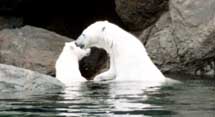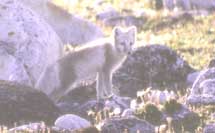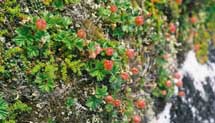 |
|||||
|
Hudson Bay • Nunavut • CanadaWildlife: Astonishing DiversityIt is not surprising that Marble Island is a traditional summer hunting ground of the Inuit. From beluga whales to polar bear to fox and loons, Marble Island and its coastline support an astonishing diversity of wildlife. Wildlife: Land AnimalsMost animals depend directly or indirectly on plants, so the Island can only support a small number of mammals year-round: Polar Bear. These animals are very dangerous (See: What you Need to Know: Polar Bears) Arctic Fox. During the winter fox follow the Polar Bear and pick up whatever scraps the bear leaves behind. Some decide to stay on the Island when lemmings are at their peak populations. By burying food close to the permafrost, a good supply of goose eggs and lemmings will last the fox until the next freeze up. Arctic Hare. Hares can weigh up to 5 kg (11 pounds). Females can have one litter of two to six young ones in June. Lemmings. They eat their own weight daily due to their high energy requirements. Their diet consist of insects, plant seeds and even meat whenever it is available. They live and travel under the snow and live in nests made of dry lyme grass, the same type that Greenlanders use in the soles of their boots. They may have up to three of four litters in a summer and are only abundant once in every four years. The species on Marble Island is the one with the extra long fore-claw. Wildlife: Marine LifeYou are likely to see beluga whale, harbour seal, ring seal, snow crab, arctic char, lump fish, caplin, sculpin, stickle back and land locked char. If you are lucky you may also see bowhead whale, narwhale, walrus, orca or harp seal. Wildlife: BirdsThe variety of birds you can see on Marble Island includes the lesser canada goose, eider duck, golden plover, guillemot, herring gull, horned lark, lapland longspur, old squaw, peregrine falcon, red phalarope, red throated loon, rock ptarmigan, rough leg hawk, sanderling, sand hill crane, savannah sparrow, scooter, snow bunting, snow goose, snowy owl, and tundra swan. There are also many varieties of small brown bird yet to be indentified during fall migration. Whalers would wrap their feet with eider duck skins as socks with the feathers inside toward the skin. Wildlife: Plants & FlowersThe surface of Marble Island is mostly bald rock, bare of plant life, yet some plants manage to survive. You will find lichens anywhere they can anchor from the constant wind. Mosses are restricted to gullies and other low lying depression where rain and snow-melt is able to accumulate. The fresh water ponds also attract migrating birds which deposit seed in their droppings -- an extra rich fertilizer that creates lush vegetation around these ponds. While the arctic willow is trying to gain a foothold, there is still no dwarf birch. You will discover Arctic daisies in bloom, especially along the beaches of coves that are piled high with rotting kelp weed. Lyme grass grows in profusion. You can also see dwarf fireweed and purple saxifrage. Wildlife: Insects The most...uh, noticeable insect on Marble Island is the Mosquito. In the summer months you are better off on Marble Island than the mainland because it's cooler and there's more of a breeze. Wolf Spiders. In early spring you can find wolf spiders frozen solid in the dry moss and lichens. They are so hard they will bounce if you throw one against a rock. But if you place the same spider close to heat it will thaw out and come back to life unharmed. Butterflies. Approximately only half of Arctic insects have been identified or catalogued to date. As recently as the early 1980's a resident of Rankin Inlet had a butterfly named after himself by the Smithsonian Institute. Since it takes years for a butterfly to evolve from an egg to an adult, they are very easily overlooked by researchers. Leaf worms. You can find leaf worms in August in the bright red cysts growing out of the dwarf willow leaves on the foundation of Knight's House. Split the hard, pimple-like growth and you will see a small thin white worm. On to the Hiking TrailsNow that you know something of the location, history, geology and wildlife of Marble Island, it's time to come and explore the the Hiking Trails. | ||||
|
|
|||||
| |
|||||



